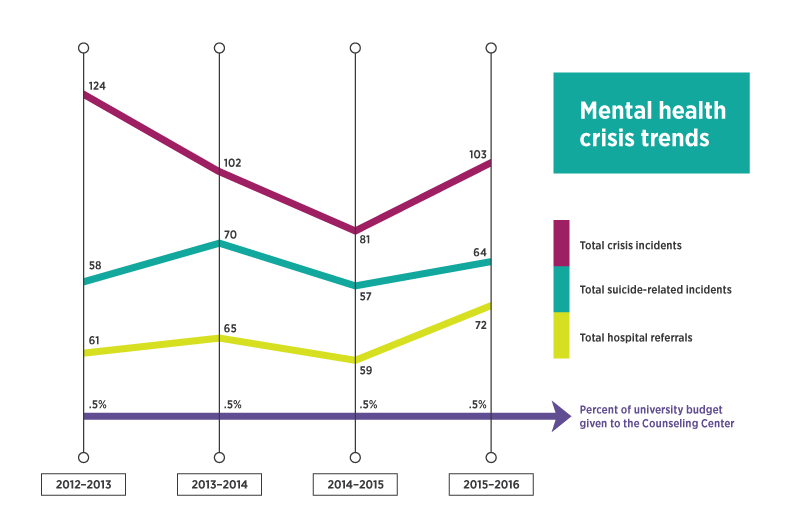Mental health crises increase at GVSU
Apr 4, 2016
Ask any counselor at the Grand Valley State University Counseling Center to show you their daily schedule, and you’ll see a never-ending series of colored blocks, one right after another. That’s become the norm for mental health professionals at colleges across the nation, especially in the last five years.
In particular, there has been a significant increase in mental health crisis incidents, involving thoughts or actions of self-harm or suicide. According to the Center for Collegiate Mental Health, there has been an increase of 18 percent in suicidal ideation in the last half decade.
At GVSU, there have been 64 cases of suicide-related mental health crises so far this year. During the 2014-15 academic year, there were 59 such instances. However, this isn’t the only type of mental health crisis that has increased this year. Through March 24, there have been 103 total mental health crises, up 22 from last year. A record number of 91 students have been involved in these incidences for the 2015-16 year to date.
This year, three GVSU students have committed suicide, and one student was unsuccessful in a serious suicidal attempt.
Though there are many potential reasons for the increase in mental health crises, Dean of Students Bart Merkle said an increase in social, political and economic instability has added to students’ anxiety and depression.
“For the typical 18-year-old college student, they’ve lived their entire lives in the shadow of Sept. 11,” Merkle said. “We also have families that have been struggling with the economy. That’s all not a very stabilizing environment, and young people aren’t immune to anxiety.”
Amber Roberts, director of the Counseling Center at GVSU, said she also believes a decrease in negative stigma around mental health has added to the rise in students the Counseling Center sees.
“We’ve always been busy, but before when we were busy, we were still able to not have session limits, or to see students more frequently,” she said. “We’re just as busy now, but we can’t do as much. The demand has definitely risen in the last five years.”
As the demand for mental health help has increased, the resources for students have been stretched thin. While students who need emergency appointments are seen the same day by a counselor, individuals who have less immediate cases may have to wait up to two weeks to get an appointment with a Counseling Center staff member.
Crisis events, marked by a traumatic event, a student not attending class, suicidal thoughts or other substantial life changes, can take up more of a counselor’s time than a less severe case.
Though the number of high-risk cases are on the rise, the Counseling Center funding has maintained at about 0.5 percent of GVSU’s overall budget in the last five years. While Roberts said she feels the Counseling Center is supported by the GVSU community, she said additional funding would be beneficial.
“Do I love having people wait longer? Of course not,” Roberts said. “I would like more funding, it’s just stiff competition for resources. Everybody has needs.”
While there does not appear to be a decrease in need for mental health resources in the near future, the university does not have any immediate plans to increase the percentage of funding the Counseling Center receives.
“I think we’ve devoted a lot of resources, we provide a lot of support for students to be successful,” Merkle said. “But, there are some limits. At some point, we have to grapple with how much of our university resources to devote (to mental health).”
Merkle said that as the university enrollment plateaus, GVSU will be able to better determine what types of resources will best serve its student population.
“We have a much larger, vibrant group program, so that two counselors can see 10 students in an hour and a half, instead of two students,” Roberts said.
Next year, Roberts hopes to roll out a triage system for Counseling Center appointments, allowing students to come in for a brief session with a counselor to determine how severe a student’s need is for future appointments.
“That will get everybody in a lot quicker, but it doesn’t solve the wait time down the road,” she said. “It’s balancing that choice of a wait at the beginning or a wait after we’ve seen you and can assess you.”
Moving forward, Merkle hopes to find the balance between resources and student need for mental health services.
“We have a very good Counseling Center, with a hardworking staff. I so appreciate how they support our students,” Merkle said. “We have to continue to look for ways to best utilize our resources.”


























